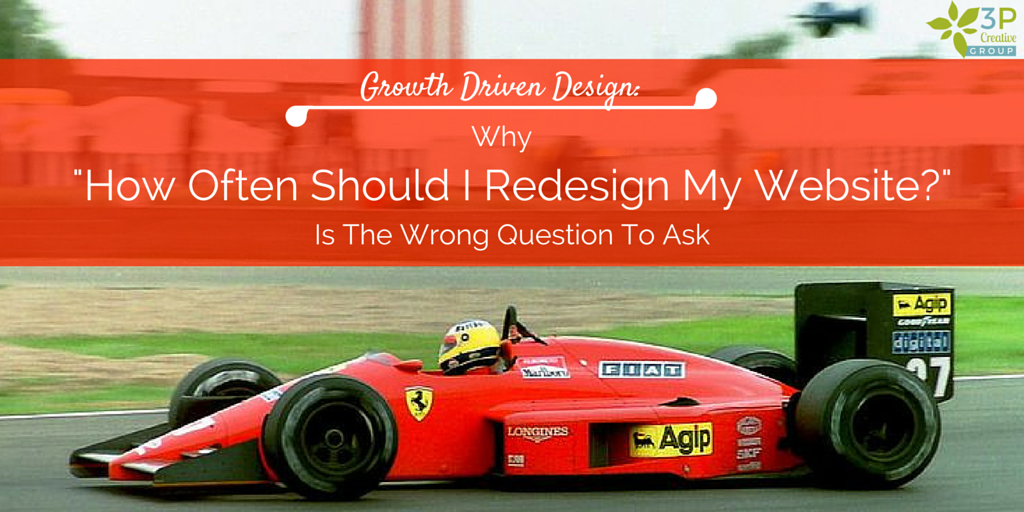Think You Are Cut Out For Doing Growth-Driven Design? Take The Quiz
Did you know that according to Hubspot, 57% of the 3,500 companies currently undergoing a traditional website design said that they expect that the redesign process will take more than six months to complete? Of that group, almost 80% won't finish their website within the next 12 months!
To make matters worse, the average website redesign costs about $55,000 and is delivered about two weeks late.
But the huge upfront cost and long cycle times aren't even the worst of it! After your expensive website finally launches, you are stuck with it for another 12-24 months. And at least one out of three marketers is unhappy with their new website. The bottom line is this: the traditional web design process is broken.
That's why we at 3P Creative Group were one of the first agencies to adopt (and become certified in) a new way of designing websites: Growth-Driven Design (GDD). Now, there are more than 1,000 agencies worldwide who are certified to answer the growing customer demand.
Growth-Driven Design Isn't For Everyone
But the sad truth is: Growth-Driven Design isn't for everyone.
While most companies would benefit from a GDD approach, there are a few red flags that indicate you should rather stick with the traditional approach. Below, we have listed the three most important ones:
1) You Trust Personal Opinions More Than Data
Let's address the biggest white elephant in the room: data! Growth-Driven Design is all about data to fuel constant improvement. Data on user behavior gleaned from heat maps. Click-though performance of certain calls-to-action. New visitor vs known visitor rates on particular website pages. You get the idea.
Some organizations thrive on data — some don't. The vast majority of businesses that do not have a data-driven approach to managing their website performance and online marketing efforts didn't have adequate tools to measure them in the past. They are simply unfamiliar with Click-Through-Rates, heat maps, and such. But as long as the organization in general (and the marketers in particular) are data-minded and understand the importance of Peter Drucker's words "you cannot manage what you cannot measure", they will be fine.
But there are some companies that put personal opinion above data. Whether they don't pursue data-driven improvements because cold, hard data points might conflict with their personal preferences or because they simply want to have the last say doesn't make a difference.
Ask yourself, for example, how design choices are made. Are they made by what management "likes" best? Or do you A/B test two to three choices and go with the top performer? If data doesn't stand a chance in the decision making process, going the Growth-Driven Design way is the wrong choice for you.
2) Your Organization Is Uncomfortable With Ongoing Projects
A lot of our clients are IT and technology companies and one of the most prevailing topics over the past three years has been Evergreen IT. Traditionally, IT managed improvements with massive big bang migration projects every 3-5 years that would always go over-budget, run late, and suck up all resources for the length of the project. With Evergreen IT, you manage your environment in smaller, iterative cycles that constantly improve your IT landscape.
Does that sound familiar?
It's just the same with the traditional website design process and Growth-Driven Design. But just like with Evergreen IT, companies that embrace GDD have to re-structure their budget approval process (GDD is an ongoing monthly retainer rather than a one-off project), assign dedicated resources to review and give feedback, and have a continuous SCRUM-based (or similar) project management approach.
If that sounds scary or impossible to implement in your organization, GDD probably isn't for you.
3) You Are Not Depending On Website Generated Leads
In the seven years that I have been building websites and doing inbound marketing, I have only encountered one company that insisted that they absolutely do not want leads being generated from their website. They asked for a very generic website that serves as an "online brochure" for their clients. When I suggested that they not include a "Contact Us" page to get them thinking about how much they really need it, they were baffled.
If you want a static web presence that will not change over the next three to five years, go ahead and go the traditional route. But for most companies, even those which generate all their business in face-to-face meetings, tradeshows, and other traditional sales tactics, having a growing pipeline of qualified leads is a desirable goal for a website redesign.
Does Your Organization Ring Any Growth-Driven Design Alarm Bells? Find Out!
Choosing between the traditional and Growth-Driven Design process can be a difficult decision — especially if you don't really know what you are getting into. To make it easier (okay, and more fun) to find out if Growth-Driven Design is the right choice for you, we have put together a quick quiz. It takes about two minutes to complete:
I hope you enjoyed this quiz and learned something about your organization and GDD in the process. If you confirmed what you know all along and you are ready to get started with GDD, let's book some time to chat! If you are still not sure, you should book a quick 30 minute coaching session with me to discuss your questions.
Share this
You May Also Like
These Related Stories

5 Reasons Why Requesting Web Design Proposals Will Set You Up To Fail

Confessions Of A Web Designer: Your New Website Will Fail - And Here's Why!

.png?width=250&height=125&name=TrustBuilderLogoWhiteTranspBackgr(250x125%20px).png)

No Comments Yet
Let us know what you think